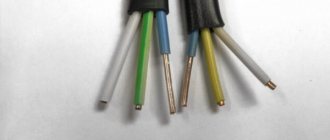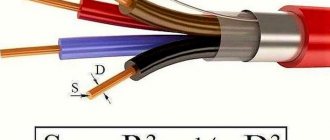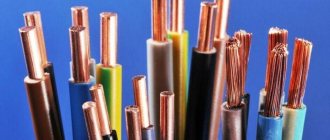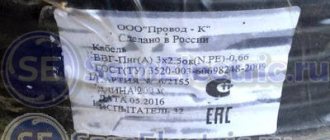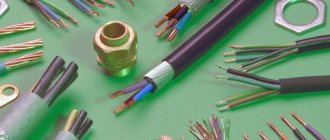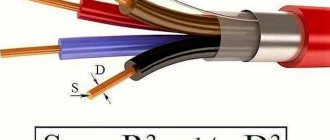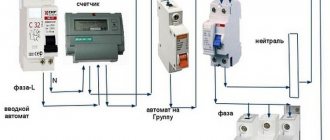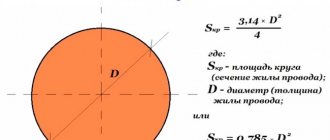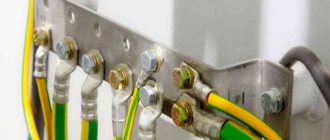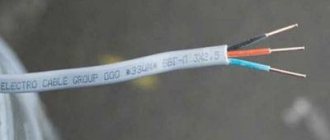Wires are widely used in the field of electrical networks for various purposes. At first glance, energy transportation through cables and wires seems simple and understandable.
However, to ensure safe operation of electrical wiring, it is necessary to take into account a number of important nuances when designing and arranging electrical networks. One of these details is the ability to correctly calculate the cross-section of a wire by diameter, because the limit of the permissible current flowing through the conductor depends on the accuracy of the determination.
How to determine the cross-section or diameter, is there a difference between these parameters? Let's try to figure it out in the article. In addition, we have prepared summary tables that will help you choose a conductor depending on the installation conditions of the electrical network, the material of the cable core and the power characteristics of the connected units.
How to find out the cable cross-section by appearance
You can determine the cable cross-section without calculations. A factory-made cable must be marked: on its outer sheath the manufacturer, type of cable, number of cores and cross-sectional area of the current-carrying core are stamped with a certain step.
For example, if the cable has the designation VVG-ng-LS 3x2.5, this means that the cable has an outer sheath and core insulation made of non-flammable PVC with no release of hazardous gases during combustion, and also such a cable has 3 conductive cores with a cross-sectional area each conductor 2.5 mm2.
The marking does not always indicate the true value of the core area, since compliance with this parameter remains on the conscience of the manufacturers. This is due to the fact that most manufacturers do not adhere to GOST during production, but are guided by their own specifications when producing cable products, which leads to a free interpretation of cross-section calculation methods and is not properly regulated. Therefore, before using the cable for its intended purpose, it is best to check that its cross-section corresponds to that stated in the marking.
Tips for choosing wire cross-section
Conductor cross-section is not all you need to pay attention to. The material from which it is made is of no small importance. A copper or aluminum core has a certain color, and if it is in doubt, then the manufacturer probably uses a metal alloy to save money. This can lead to dangerous consequences, since the current conductivity will be less than that of the declared metals.
The cross-section of the wire is determined only by the diameter of the current-carrying core. Some buyers mistakenly try to calculate the cross-section by the total diameter (core + insulation), subtracting the estimated insulation thickness from the result. This should not be done under any circumstances, as the measurement error will be excessively high. In addition, in order to save metal, the manufacturer can make the insulation itself thicker, and in appearance the product seems quite normal.
Segment cable cross-section
When working with conductors, it is necessary to understand their designation. There are wires and cables that differ from each other in their internal structure and technical characteristics. However, many people often confuse these concepts.
A wire is a conductor that has in its design one wire or a group of wires woven together and a thin common insulating layer. A cable is a core or a group of cores that has both its own insulation and a common insulating layer (sheath).
Each type of conductor will have its own methods for determining cross sections, which are almost similar.
The amount of energy that a conductor transmits depends on a number of factors, the main one of which is the material of the current-carrying conductors. The following non-ferrous metals can be used as the core material of wires and cables:
- Aluminum. Cheap and lightweight conductors, which is their advantage. They are characterized by such negative qualities as low electrical conductivity, a tendency to mechanical damage, high transient electrical resistance of oxidized surfaces;
- Copper. The most popular conductors, which have a high cost compared to other options. However, they are characterized by low electrical and transition resistance at the contacts, fairly high elasticity and strength, and ease of soldering and welding;
- Aluminum copper. Cable products with aluminum cores coated with copper. They are characterized by slightly lower electrical conductivity than their copper counterparts. They are also characterized by lightness, average resistance and relative cheapness.
Various types of cables according to core material
Important! Some methods for determining the cross-section of cables and wires will depend specifically on the material of their conductor component, which directly affects the throughput power and current strength (method for determining the cross-section of conductors by power and current)
Aluminum cable with sector conductors
In such cases, it is necessary to resort to a table where the size (height, width) of the cable takes the corresponding value of the cross-sectional area. Initially, it is necessary to measure the height and width of the required segment with a ruler, after which the required parameter can be calculated by correlating the obtained data.
Table for calculating the area of an electric cable core sector
| Cable type | Sectional area of the segment, mm2 | ||||||||
| S | 35 | 50 | 70 | 95 | 120 | 150 | 185 | 240 | |
| Four-core segment | V | – | 7 | 8,2 | 9,6 | 10,8 | 12 | 13,2 | – |
| w | – | 10 | 12 | 14,1 | 16 | 18 | 18 | – | |
| Three-core segmental stranded, 6(10) | V | 6 | 7 | 9 | 10 | 11 | 12 | 13,2 | 15,2 |
| w | 10 | 12 | 14 | 16 | 18 | 20 | 22 | 25 | |
| Three-core segmental single-wire, 6(10) | V | 5,5 | 6,4 | 7,6 | 9 | 10,1 | 11,3 | 12,5 | 14,4 |
| w | 9,2 | 10,5 | 12,5 | 15 | 16,6 | 18,4 | 20,7 | 23,8 |
Calculation of the cross-section of electrical wiring according to the power of connected electrical appliances
To select the cross-section of cable wire cores when laying electrical wiring in an apartment or house, you need to analyze the fleet of existing electrical household appliances from the point of view of their simultaneous use. The table provides a list of popular household electrical appliances indicating the current consumption depending on the power.
You can find out the power consumption of your models yourself from the labels on the products themselves or data sheets; often the parameters are indicated on the packaging. If the current consumed by an electrical appliance is not known, it can be measured using an ammeter.
Typically, the power consumption of electrical appliances is indicated on the housing in watts (W or VA) or kilowatts (kW or kVA). 1 kW=1000 W.
Table of power/current consumption of household electrical appliances
| electrical appliance | Power consumption, W | Current strength, A |
| Washing machine | 2000 – 2500 | 9,0 – 11,4 |
| Jacuzzi | 2000 – 2500 | 9,0 – 11,4 |
| Electric floor heating | 800 – 1400 | 3,6 – 6,4 |
| Stationary electric stove | 4500 – 8500 | 20,5 – 38,6 |
| microwave | 900 – 1300 | 4,1 – 5,9 |
| Dishwasher | 2000 – 2500 | 9,0 – 11,4 |
| Freezers, refrigerators | 140 – 300 | 0,6 – 1,4 |
| Electric meat grinder | 1100 – 1200 | 5,0 – 5,5 |
| Electric kettle | 1850 – 2000 | 8,4 – 9,0 |
| Electric coffee maker | 630 – 1200 | 3,0 – 5,5 |
| Juicer | 240 – 360 | 1,1 – 1,6 |
| Toaster | 640 – 1100 | 2,9 – 5,0 |
| Mixer | 250 – 400 | 1,1 – 1,8 |
| Hairdryer | 400 – 1600 | 1,8 – 7,3 |
| Iron | 900 –1700 | 4,1 – 7,7 |
| Vacuum cleaner | 680 – 1400 | 3,1 – 6,4 |
| Fan | 250 – 400 | 1,0 – 1,8 |
| TV | 125 – 180 | 0,6 – 0,8 |
| Radio equipment | 70 – 100 | 0,3 – 0,5 |
| Lighting devices | 20 – 100 | 0,1 – 0,4 |
Current is also consumed by the refrigerator, lighting fixtures, radiotelephone, chargers, and TV in standby mode. But in total this power is no more than 100 W and can be ignored in calculations.
If you turn on all the electrical appliances in the house at the same time, you will need to select a wire cross-section capable of passing a current of 160 A. You will need a finger-thick wire! But such a case is unlikely. It’s hard to imagine that someone is capable of grinding meat, ironing, vacuuming and drying hair at the same time.
Calculation example. You got up in the morning, turned on the electric kettle, microwave, toaster and coffee maker. The current consumption will accordingly be:
7 A + 8 A + 3 A + 4 A = 22 A
Taking into account the switched on lighting, refrigerator and, in addition, for example, a TV, the current consumption can reach 25 A.
Selecting a wire cross-section for connecting electrical appliances to a three-phase 380 V network
When operating electrical appliances, for example, an electric motor, connected to a three-phase network, the consumed current no longer flows through two wires, but through three and, therefore, the amount of current flowing in each individual wire is somewhat less. This allows you to use a smaller cross-section wire to connect electrical appliances to a three-phase network.
To connect electrical appliances to a three-phase network with a voltage of 380 V, for example an electric motor, the wire cross-section for each phase is taken 1.75 times less than for connecting to a single-phase network of 220 V
Attention, when choosing a wire cross-section for connecting an electric motor based on power, you should take into account that the nameplate of the electric motor indicates the maximum mechanical power that the motor can create on the shaft, and not the electrical power consumed
For example, you need to connect an electric motor that consumes power from a 2.0 kW network. The total current consumption of an electric motor of such power in three phases is 5.2 A. According to the table, it turns out that a wire with a cross-section of 1.0 mm2 is needed, taking into account the above 1.0 / 1.75 = 0.5 mm2. Therefore, to connect a 2.0 kW electric motor to a three-phase 380 V network, you will need a three-core copper cable with a cross-section of each core of 0.5 mm2.
It is much easier to choose the wire cross-section for connecting a three-phase motor based on the current consumption, which is always indicated on the nameplate. For example, the current consumption of a 0.25 kW motor for each phase at a supply voltage of 220 V (the motor windings are connected in a delta configuration) is 1.2 A, and at a voltage of 380 V (the motor windings are connected in a star configuration) it is only 0.7 A.
Taking the current strength indicated on the nameplate, according to the table for selecting the wire cross-section for apartment electrical wiring, we select a wire with a cross-section of 0.35 mm2 when connecting the electric motor windings in a “triangle” pattern or 0.15 mm2 when connecting in a “star” pattern.
How to determine whether the parameters match?
As a rule, extreme care on your part allows you to avoid such incidents during the purchase:
- A normal wire must have its marking, which provides the buyer with all the information about the model, operating features, and parameters. If you encounter questionable products, you may find that the product data is not presented in full or is completely missing.
- If the conductor is really good, he must be provided with quality certificates. The technical documentation indicates that it was not only manufactured in accordance with the ND, but also passed the appropriate tests.
- A good wire cannot cost a penny - since the price of materials is quite high, the cheapness should make you wonder if there is some kind of catch in this. If you wish, you can come to the store with a micrometer or caliper and perform a test to clear your doubts.
Determination of cross-section by diameter
After determining the diameter of the wire, you can begin to calculate the cross-sectional area in squares (mm2). For cables of the VVG type, consisting of three single-core conductors, calculation methods are used using a formula or a ready-made table of diameters and areas. The methods are also applicable to products with other markings.
According to the formula
The main method is to calculate using a formula of the form - S=(n/4)*D2, where π=3.14, and D is the measured diameter. For example, to calculate the area with a diameter of 1 mm, you will need to calculate the value: S=(3.14/4)*1²=0.785 mm2.
Online calculators are available on the Internet that allow you to calculate the area of a circle by diameter. Before purchasing a cable, it is recommended to calculate the values in advance, put them in a table and use it in the store.
The video from user Alexander Kvasha demonstrates checking the cross-section of wire cores.
According to the table with common diameters
To simplify the calculation, it is convenient to use a ready-made table.
The order of using numbers from the table:
- Select the type of wire that you intend to purchase, for example, VVG 3*4.
- Determine the diameter from the table - a section of 4 mm2 corresponds to a diameter of 2.26 mm.
- Check the actual wire diameter. If there is a match, the products can be purchased.
Below is a table of the ratio of cross-sections of the main types of copper wiring to diameters and current (at a voltage of 220 V).
| Wire core diameter, mm | Core cross-section, mm2 | Allowable current, A |
| 1,12 | 1 | 14 |
| 1,38 | 1,5 | 15 |
| 1,59 | 2,0 | 19 |
| 1,78 | 2,5 | 21 |
| 2,26 | 4,0 | 27 |
| 2,76 | 6,0 | 34 |
| 3,57 | 10,0 | 50 |
| 4,51 | 16,0 | 80 |
| 5,64 | 25,0 | 100 |
| 6,68 | 35,0 | 135 |
An additional criterion for matching the cross-section to the diameter is the weight of the wire. The method of determining diameter by weight is used when testing thin wire for winding transformers. The thickness of the product starts from 0.1 mm, and it is difficult to measure it with a micrometer.
A brief table of correspondence between vein diameters and weight is given below. Detailed data is available in stores specializing in the sale of electronic components.
| Diameter, mm | Section, mm2 | Weight, g/km |
| 0,1 | 0,0079 | 70 |
| 0,15 | 0,0177 | 158 |
| 0,2 | 0,0314 | 281 |
| 0,25 | 0,0491 | 438 |
| 0,3 | 0,0707 | 631 |
| 0,35 | 0,0962 | 859 |
| 0,4 | 0,1257 | 1,122 |
When calculating the wire diameter for fuses, the conductor material should be taken into account. A brief table of cable diameters from common types of material and current strength is given below.
| Break current, A | Copper | Aluminum | Nikelin | Iron | Tin | Lead |
| 0,5 | 0,03 | 0,04 | 0,05 | 0,06 | 0,11 | 0,13 |
| 1 | 0,05 | 0,07 | 0,08 | 0,12 | 0,18 | 0,21 |
| 5 | 0,16 | 0,19 | 0,25 | 0,35 | 0,53 | 0,60 |
| 10 | 0,25 | 0,31 | 0,39 | 0,55 | 0,85 | 0,95 |
| 15 | 0,32 | 0,40 | 0,52 | 0,72 | 1,12 | 1,25 |
| 25 | 0,46 | 0,56 | 0,73 | 1,00 | 1,56 | 1,75 |
| 50 | 0,73 | 0,89 | 1,15 | 1,60 | 2,45 | 2,78 |
| 100 | 1,15 | 1,42 | 1,82 | 2,55 | 3,90 | 4,40 |
| 200 | 1,84 | 2,25 | 2,89 | 4,05 | 6,20 | 7,00 |
| 300 | 2,40 | 2,95 | 3,78 | 5,30 | 8,20 | 9,20 |
For multi-core cable
The diameter of a multi-core cable is determined by the cross-sectional size of one conductor multiplied by their number. The main problem is measuring the diameter of a thin wire.
An example is a cable consisting of 25 cores with a diameter of 0.2 mm. According to the above formula, the cross-section is equal to: S=(3.14/4)*0.2²=0.0314 mm2. With 25 cores it will be: S=0.0314*25=0.8 mm2. Then, using the correspondence tables, it is determined whether it is suitable for transmitting the current of the required strength or not.
Another way to approximately calculate the current strength is to multiply the diameter of a multi-core cable by an adjustment factor of 0.91. The coefficient provides for a non-monolithic wire structure and air gaps between the turns. The outer diameter is measured with little effort, since the surface is easily deformed and the cross-section becomes oval.
When calculating the segment part of the cable, formulas or table values are used. The table shows the standard values for segment width and height.
| Sectional area, mm2 | 35 | 50 | 70 | 95 | 120 | 160 | 185 | 240 |
| Height/width for three-core monolithic cable, mm | 5,5/9,2 | 6,4/10,5 | 7,6/12,5 | 9/15 | 10,1/16,6 | 11,3/18,4 | 12,5/20,7 | 14,4/23,8 |
| Height/width for three-core cable made of thin cores, mm | 6/10 | 7/12 | 9/14 | 10/16 | 11/18 | 12/20 | 13,2/22 | 15,2/25 |
| Height/width for four-core monolithic cable, mm | No | 7/10 | 8,2/12 | 9,6/14,1 | 10,8/16 | 12/18 | 13,2/18 | No |
Electric current (wire diameter)
Quite often you can encounter a situation where the power of electrical equipment and equipment is not known to the owner due to the absence of this characteristic in the documentation or the loss of the necessary documents and labels. There is always a way out. For this situation, it is as follows: make the calculation using the formula yourself. Power is determined by the formula:
P = U*I,
Where:
P – power, measured in watts (W);
I – electric current strength, measured in amperes (A);
U is the applied electrical voltage, measured in volts (V).
When the strength of the electric current is unknown, it can be measured with control and measuring instruments: an ammeter, a multimeter, and a clamp meter.
After determining the power consumption and electric current, you can use the table below to find out the required cable cross-section.
Measuring with pliers
| Wire cross-section. | Electrical voltage 220 V | Electrical voltage 380 V |
| Current strength A; Power, kWt | Current strength A; Power, kWt | |
| 2,5 | 27 5,9 | 25 16,5 |
| 4 | 38 8,3 | 30 19,8 |
| 6 | 50 11 | 40 26,4 |
| 10 | 70 15,4 | 50 33 |
| 16 | 90 19,8 | 75 49,5 |
| 25 | 115 25,3 | 90 59,4 |
| 35 | 140 30,8 | 115 75,9 |
| 50 | 175 38,5 | 145 95,7 |
| 70 | 215 47,3 | 180 118,8 |
| 95 | 260 57,2 | 220 145,2 |
| 120 | 300 66 | 260 171,6 |
Section calculation
If there is a cable in front of you, the cross-section of which you do not know (there is no marking), then this indicator can be calculated independently using the formula for the area of a circle:
S=πd²/4=0.8d².
That is, you measure the diameter of the core with your own hands using a caliper and insert this indicator into the formula. If the marking on the wire remains, for example, VVG 3x1.5, then this means that you have a three-core wire with a cross-section of 1.5 mm².
But it is also necessary to take into account the fact that wires are different in terms of the material from which they are made. All electrical cables are based on either copper or aluminum. So, copper cables can withstand a higher current load than aluminum cables. In addition, they practically do not oxidize, so when you are faced with a choice, it is best to give preference to the copper option.
There is one more point that needs to be taken into account. This is the method of wiring a power supply circuit. That is, the electrical cable was laid in grooves and plastered, or the wiring was carried out in a corrugated hose, or open electrical wiring was made. What is the difference?
The thing is that internal wiring (hidden) creates conditions under which the wire ends up in a confined space. That is, when heated, it does not give off heat to the air that surrounds it. This means it overheats faster and more. And this, in turn, reduces the service life and creates conditions for rapid failure. That is, in such wiring it is necessary to use wires with a cross-section slightly larger than the nominal one.
Current Density
Gradually, understanding electrical wires, or more precisely, the choice of cable cross-section, we came to another equally important indicator - current density. What it is? Essentially, this is the same current strength, measured in amperes, that passes through a standard cross-section of an electrical wire equal to one millimeter squared
Let's just say that this is a relative value, so it can be used in the formula that determines the diameter of the wire:
d=1.1*√I/Ip, where Ip is the current density.
Now you can calculate the cross-section of the wire by substituting the value of “d” into the area formula. Ultimately we get that S=I/Ip.
But where then can I get the “Ip” readings? These are standard values, depending again on the material from which the wires are made and the type of wiring. The table below shows this relationship.
Area of a circle
| Material | Copper | Aluminum |
| Hidden wiring | 6 A/mm² | 4 |
| Open wiring | 10 | 6 |
As we said above, copper is preferable in this case.
Let's look at one simple calculation example. Input data:
- The wire is copper.
- Open wiring.
- Cable load 2.2 kW.
First, we find the current strength in the electrical circuit: I=P/U=2200 W:220 V= 10 A.
Now we find the cross-section of the wire itself: S=I/Ip=10:10=1 mm², where the second number “10” is selected from the above table. Thus, you can independently calculate all cable cross-sections in each section of the electrical network at home. The main thing is to correctly calculate the power consumption on each loop. And this, as you know, is the total power of all household appliances and lighting bulbs. For example, if you are calculating a kitchen area, you will have to add up the power of all devices, and this is a refrigerator, microwave, coffee maker, electric kettle, hood, blender, and so on, plus lighting. This indicator is indicated on instrument tags and glass lamp housings.
In principle, you can assemble such a table of wire cross-sections for yourself, taking into account all the layouts described above. That is, if you know the power consumption on all electrical circuits, then you can divide the cables into sections depending on their cross-section.
Power of some household electrical appliances
- Firstly, it will simplify installation. That is, you will never get confused where which cable should be laid.
- Secondly, it will be possible to calculate the costs associated with the purchase of wiring, and thereby determine the repair budget.
- Thirdly, the table will help in the future. If the power consumption does not change over the years, then you will not need to do all the calculations again. It is enough to get a table and remember what cross-section the cable is and where it was laid.
Parallel connection of electrical wiring wires
There are hopeless situations when you urgently need to lay wiring, but there is no wire of the required cross-section available. In this case, if there is a wire with a smaller cross-section than necessary, then the wiring can be made from two or more wires, connecting them in parallel. The main thing is that the sum of the sections of each of them is not less than the calculated one.
For example, there are three wires with a cross section of 2, 3 and 5 mm2, but according to calculations, 10 mm2 is needed. Connect them all in parallel and the wiring will handle up to 50 amps. Yes, you yourself have repeatedly seen the parallel connection of a large number of thin conductors to transmit large currents.
For example, welding uses a current of up to 150 A and in order for the welder to control the electrode, a flexible wire is needed. It is made from hundreds of thin copper wires connected in parallel. In a car, the battery is also connected to the on-board network using the same flexible stranded wire, since when starting the engine, the starter consumes a current of up to 100 A from the battery.
And when installing and removing the battery, it is necessary to move the wires to the side, that is, the wire must be flexible enough. The method of increasing the cross-section of an electrical wire by connecting several wires of different diameters in parallel can be used only as a last resort. When laying home electrical wiring, it is permissible to connect in parallel only wires of the same cross-section taken from the same reel.
Different ways: how to determine the wire cross-section
A conductor is often referred to by two different words – wire and cable. This mixture is very inconvenient. In everyday life, these concepts are often confused, although there are some significant differences in the operation of these devices. In order to correctly determine and correctly find out the cross-sectional area, it is necessary to understand the differences between these conductors and understand a more or less accurate definition.
A conductor consists of a group of cores that are enclosed in separate insulation or in common insulation. The cores come in different types, usually woven or solid, depending on the wire model. Their diameter is measured both with a regular ruler and with a special device - a caliper. As a rule, conductors are made of various non-ferrous metals.
Typically the materials are as follows:
- Copper;
- Aluminum;
- Aluminum copper – (this is an alloy of aluminum and copper specially developed by scientists).
All these materials are distinguished by a relatively low price, low electrical resistance, fairly high electrical conductivity, ease of welding and installation
Another important characteristic is the minimal weight of the metal wire. The methods for finding the cross-sectional area of the above conductors are almost the same, and measuring it is not difficult at all
Connect wires of different sections using bolts
Another way to connect wires of different sections to each other is to create contact using bolts, washers and nuts. According to professional electricians, this connection is the most durable and strong. The process itself is not too complicated and takes minimal time. The procedure goes as follows:
- the copper conductors of the wire are carefully stripped (the length of the stripped section of the conductor depends on the diameter of the bolt);
- the stripped core is bent into a loop;
- the loop is put on the bolt;
- an intermediate washer is installed on top;
- then a loop of wire of a different cross-section is put on and secured with an intermediate washer.
This continues until all the wires are connected to each other. After putting on the last loop and the last washer, the structure is firmly tightened with a nut.
How to determine
There are several ways to determine this value of an electrical wire. There are formulas that can be used to calculate a parameter or tables that contain all the values of common standard conductors. Knowing one parameter, for example, the diameter of the core, its current-carrying capacity, you can also find out the cross-section. Other methods of determination are:
- according to the formula through the diameter - S=π*R², where R is ½ the diameter (d), and π=3.14;
- measuring instrument - micrometer;
- using a caliper;
- when using a pencil or pen;
- ruler based on diameter.
A micrometer, as well as a caliper, helps to determine the most accurate diameter, and then, based on it, calculate the cross-section using the formula: S= d*d*d/4, the result will be in mm². Using tools, conductive elements of a circular cross-section are measured, but they are quite expensive and therefore it is not practical to buy them for one time.
To determine using a pen or pencil (a marker, felt-tip pen, etc. are suitable), first cut off the insulation. Then the core is tightly wound around the writing instrument along its entire length. Then measure the length of the winding with a ruler and divide it by the number of turns to find out the diameter. The more turns are made, the more accurate the calculation. When the diameter has become known, the cross-section is calculated using a special formula.
You can calculate this parameter using only a ruler, but the core must be thick enough. The diameter is determined with thread or thin paper - for greater accuracy. A strip is torn from the sheet and folded on one side. The paper is then wrapped around the core until it touches the strip. At the joint, bend it again and apply it to a ruler for measurement. The same applies to thread. The diameter is calculated using the formula: d=l/2π, where l is the length of the paper or thread. Then they use the standard calculation - S=π*R² to determine R, d (diameter) divided by 2.
Conductor markings (wire diameter)
If the cross-section coincides with that indicated on the tag, great, you can safely take it. But when the resulting result is much less, you should opt for a more powerful cable that has the next best parameters. Otherwise, you can look for wires in other stores. Unfortunately, high-quality goods that meet GOST standards are not so easy to come by these days. Remember that a high-quality cable will not be cheap. The conclusion follows from this: if you want to get a quality product, look for trusted stores with markings that comply with GOST.
Before making a final decision - to take or not to take the wire, it is necessary to inspect the insulation very carefully. The plastic shell of the core must be continuous, have an impressive thickness, which will be the same along the entire length. If, in addition to discrepancies in diameter, negative nuances with the braid are also revealed, then of course you need to look for another store where the cable would be purchased elsewhere and from a completely different manufacturer. It's better not to take risks with electricity.
Therefore, it is better to overpay, perhaps spend more time searching, but buy a high-quality conductor made according to GOST, and not made according to specifications. In this case, you can guarantee that the cable will serve the time stated in the documents without any problems, and, most likely, much longer. The choice of wires is a very serious matter, and it certainly cannot be handled carelessly. You should not risk the building just to reduce the search time or save extra pennies.
Conditions for working with a table of cable cross-sections by diameter
The cable cross-section tables differ in some characteristics from the wire data, but the main characteristics and concepts are still the same - diameter and area. The calculation and its principle are not particularly different. In addition, the cable cross-section table invariably contains the following characteristics, for example, power, current, resistance of a particular material (copper or aluminum).
It should also be remembered that over time, the load can increase significantly for various reasons independent (including) from the owner of the apartment. In order not to create a fire hazard in your own apartment, it is advisable to select wires together with a qualified installation specialist, and to install these wires/cables and connections together with them.
Of course, the data provided in this table is adequate to reality only if certain conditions are met:
- The air temperature is slightly less than or equal to, for example, +30 ᵒC (it is clear that the temperature is different for each table, usually additional conditions are specified).
- The network voltage is 220 V.
- The wire is three-core, with general insulation.
- Separate grounding.
- Laying in a closed space - in the air or in a box.
There are also other conditions that it is advisable not to neglect in order to avoid dangerous and difficult situations associated with equipment failure or a threat to the safety (life and health) of people.
We measure the cross-section of wires depending on the diameter
The cross-section of a cable or other types of conductors is determined in several ways. The main thing is to take care of preliminary measurements. To do this, it is recommended to remove the top layer of insulation.
About measuring instruments, description of the process
Calipers and micrometers are the main tools that help in measurements. Most often, preference is given to devices of the mechanical group. But it is also permissible to choose electronic analogues. Their main difference is digital special screens.
Electronic caliper
Vernier calipers are among the tools found in every household. Therefore, it is often chosen when measuring the diameter of wires and cables. This also applies to cases where the network continues to operate - for example, inside an outlet or panel device.
The following formula helps determine the cross-section based on the diameter:
S = (3.14/4)*D2.
D is a letter indicating the diameter of the wire.
If there is more than one core in the structure, then measurements are carried out for each of the component elements separately. After this, the results obtained are added to each other.
Then everything can be calculated using the following formula:
Stotal= S1+ S2+…
Stotal is an indication of the total cross-sectional area.
S1, S2 and so on are the cross sections defined for each of the cores.
It is recommended to measure the parameter at least three times to ensure accurate results. The conductor is turned in different directions every time. The result is an average value that is as close as possible to reality.
A regular ruler can be used if a caliper or micrometer is not at hand. The following manipulations are expected to be performed:
- Complete cleaning of the insulation layer near the core.
- Winding the turns around the pencil, as tightly as possible to each other. The minimum number of such components is 15-17 pieces.
- The winding is measured by its overall length.
- The final value is divided by the number of turns.
The accuracy of the measurement is questionable if the turns do not fit evenly on the pencil, leaving gaps of certain sizes. To ensure higher accuracy, it is recommended to measure the product from different sides. It is difficult to wind thick strands onto regular pencils. It is still better to use calipers.
The cross-sectional area of the wire is calculated using the formula described earlier. This is done after completing the main measurements. You can rely on special tables.
The micrometer is recommended to be used in cases where the composition contains ultra-thin conductors. Otherwise, there is a high probability of mechanical damage.
Table of correspondence of wire diameters and their cross-sectional area
Determining the size of the cable cross-section
Cables can be either single-core or multi-core. In the second case, it is best to determine the diameter of each individual core. Also, the core can be single-wire or consist of many wires. Regardless of the type of cable, you can determine its cross-section by diameter.
However, do not forget that “it’s also written on the fence” and it is best to carry out all the necessary measurements yourself when choosing a wire. Fortunately, carrying them out is not that difficult. Determining the actual wire diameter is possible using available tools. Such tools include a micrometer and a caliper.
Micrometer measurement
The most accurate method for measuring diameter is using a micrometer. For such a measurement, you need to take a conductor and move the measuring screw to it until the characteristic ratcheting sound appears. The exact diameter value consists of two values: on the micrometer rod and on the drum.
Measuring with a caliper
You can also measure the cable diameter using a common tool such as a caliper. To do this, you need to clamp the wire to be measured between the jaws of the meter and read the exact value from a special scale.
Measuring with a ruler
The least accurate type of measurement is using a simple ruler. However, in this case, accuracy can be achieved by measuring a large number of turns. The procedure for measuring with a ruler:
- A conductor is wound around a certain rod over a certain distance.
- The length of the wrapped section of the rod is measured with a ruler.
- The resulting value is divided by the number of turns.
This method still has a certain accuracy due to the reduction in error.
Next, you can determine the cable cross-section by diameter. This can be done using the formula:
S = π*D2/4
where D is the measured diameter of the wire.
On this topic:
BACK FORWARD 1 of 2
The skill of independently calculating the conductor cross-section will help you avoid all sorts of problems in the future, as well as deception on the part of the product supplier.
Tables and norms
Another very common method for determining the wire cross-section by diameter is the use of standardized tables that list all the most common and widely used cable cross-sections.
The procedure for selecting the wire cross-section according to the table:
- First you need to decide on the type of cable.
- Next, we find the diameter we need in the table.
- We determine the appropriate section.
- If necessary, we independently check the indicators using the methods described above and make a decision on purchase.
Table of wire cross-sections by diameter.
| Wire core diameter, mm | Core cross-section, mm2 |
| 1,12 | 1 |
| 1,38 | 1,5 |
| 1,59 | 2,0 |
| 1,78 | 2,5 |
| 2,26 | 4,0 |
| 2,76 | 6,0 |
| 3,57 | 10,0 |
| 4,51 | 16,0 |
| 5,64 | 25,0 |
| 6,68 | 35,0 |
The table relating wire cross-section and diameter shows that the formula described above is very fair. The cross-section values given in the proposed table are calculated precisely from it with certain permissible roundings.
So, we already know how to independently find out the wire cross-section. All that remains is to put the acquired knowledge to good use.
When purchasing a cable, you can ask the seller to strip a small section of the wire in order to carry out all the necessary manipulations to measure the product. However, practice shows that not many sellers take such a step. Then the only solution is to first purchase a small section of cable needed for measurements. But after all doubts have disappeared, you can purchase as much wire as you need. Still, the not most joyful fact is that truly attentive buyers often choose a cable with a larger cross-section. After all, in reality they turn out to be somewhat smaller than the formal sizes.
Determination methods
There are several ways to determine cable cross-section. They all boil down to first calculating the diameter of the core, and then using small calculations to find out the final value.
Method No. 1 – Devices to help!
Today, there are engineering instruments with which you can easily determine the diameter of a wire or cable core. Such instruments include a caliper and a micrometer (click on the photo to view all the tools).
This method of determination is the most accurate, but the “other side of the coin” is the cost of the caliper/micrometer itself. The price, of course, is not astronomical, but for one-time use there is no point in purchasing this tool.
Most often, this option is chosen by professional electricians, whose lives are directly related to the installation of electrical wiring. Having a caliper, you can most accurately determine the cross-section of the wire on your own. The advantage of this technique is that you can measure the diameter of the cores even on a section of a working line (for example, in a socket).
After the measurement, you must use the following formula:
Don't forget that Pi is 3.14. To simplify the formula as much as possible, you can divide 3.14 by 4, after which the calculations will be reduced to multiplying 0.785 by the diameter squared!
Method number 2 - Using a ruler
If you do not want to spend money (and you are doing the right thing!), then we recommend using a simple “old-fashioned” method to determine the cross-section of the wire by its diameter. If you have a wire, a simple pencil and a ruler, you can find the answer in a matter of minutes. All you need is to strip the core of insulation, then tightly wind it onto a pencil (as shown in the picture) and use a ruler to measure the total length of the winding.
The essence of the method is that it is necessary to measure the total length of the wound conductor and divide it by the number of cores. The resulting value is the diameter that you need to determine.
Despite its simplicity, the calculations have their own peculiarity:
- the more cores are wound around the pencil, the more accurate the result will be, the minimum number of turns is 15;
- the turns must be pressed tightly against each other so that there is no free space, which will significantly increase the error;
- the determination must be carried out several times (changing the initial side of the measurement, turning the ruler over, etc.). Again, the more calculations, the smaller the error.
We draw your attention to the significant disadvantages of this method. Firstly, only thin conductors are suitable for measurement (due to the fact that a thick cable will be difficult to wind). Secondly, in the store before purchasing for this technique, you need to separately purchase a small piece of the product
Secondly, in the store before purchasing for this technique, you need to separately purchase a small piece of the product.
After all the measurements, you must use the same formula that we indicated above. The video shows an example of determining the cross-section of a conductor using a ruler:
Using rulers and formulas
Method #3 – Using tables
Instead of determining the cable cross-section using a formula, you can simply use ready-made tables that will reduce your time and make the result more accurate.
The table is quite simple: one column shows the diameters of the cores, the second shows their cross sections in squares.
Formula: how to determine cable cross-section
The concept of cross-sectional area, or, in common parlance, cable thickness is an interesting thing. It is determined by a device called a caliper. First, using this device, you need to calculate the diameter of the conductor (of course, previously cleared of insulation).
Then you should find the cable area using the formula S = π (D/2)2, in this formula:
- S is the cross-sectional area of a stranded or solid conductor, which is expressed in mm2.
- π = 3.14 (the banal, well-known number Pi).
- D is the diameter of the electrically conductive cable core, expressed in mm.
Conversion to other units of measurement or to the SI system is optional. You can also write this formula in abbreviated form: S = 0.8 D² (the area is equal to the product of 0.8 and the square of the diameter). In this case, 0.8 D² is a rounded factor. In fact, calculating the cross-sectional area and the ratio of different parameters of the conductor is not at all difficult.
By the way, it is very convenient to measure the cross-sectional area with a micrometer or use a calculator.
Of course, it will not give an exact number, like 16mm2, but it will make the calculations much easier. Watching a video about this is quite boring, but it can be quite useful, especially if you decide to do home renovations yourself (this is not a very good idea, but your apartment is your rules).
What is a section
But first, let's understand the concepts. Cross-section is the cross-sectional area of a wire, which can be easily measured by cutting the cable in half. Only the size of the copper or aluminum conductor is included in the value, and the insulating layer is not taken into account.
To find out what the cut area of a particular conductor is, you can look at the table of cross-sections of wires of a certain type, brand and manufacturer. There you can also see the influence of this value on other operational characteristics of the cable.
For example, the larger the section, the higher it is:
- Rated voltage;
- Maximum load;
- Thickness of the insulating layer.
That is, if you do not pay due attention to the calculation and selection of the cross-section, and connect wires of different cross-sections into one line, you can build a conductor with completely opposite, inappropriate and inappropriate parameters into the existing wiring. The result will be disastrous: current leakage, short circuit, risk to life, health and property of residents.
How to calculate the cross-section of a copper wire and determine the load on the cable
| Max. power, kWt | Max. load current, A | Wire cross-section, mm2 | Circuit breaker current, A |
| 4.5 | 4-6 | ||
| 9.1 | 1.5 | ||
| 13.6 | 2.5 | ||
| 18.2 | 2.5 | ||
| 22.7 | |||
| 27.3 | |||
| 31.8 | |||
| 36.4 | |||
| 40.9 | |||
| 45.5 | |||
| 50.0 | |||
| 54.5 | |||
| 59.1 | |||
| 63.6 | |||
| 68.2 | |||
| 72.7 | |||
| 77.3 |
This table shows the data for the following case.
— Single phase, voltage 220 V
— Ambient temperature 30 C
— Laying in the air or in a box (in a closed space)
— Three-core wire, in general insulation (cable)
— The most common TN-S system with a separate ground wire is used
— The consumer reaching maximum power is an extreme but possible case. In this case, the maximum current can operate for a long time without negative consequences.
If the ambient temperature is at least 20 C higher, or if there are several cables in the bundle, it is recommended to select a larger cross-section.
It is also important to know what kind of wire you are buying. Some manufacturers underestimate the cross-section of the cable cores to save money and time
There are a number of companies making such wires (I will not list them).
But there are also those who make high-quality, but expensive wires
This is worth paying maximum attention to
In the process of determining the cross-section of the wire by diameter, it is necessary to pay attention to the metal of the core. Copper or aluminum conductor is characterized by a bright, rich color
If the color is in doubt, then we can conclude that the quality is low. Most likely, the manufacturer simply saved on metal by using a metal alloy for manufacturing.
The alloy is dangerous for installation work, because the rated load and current conductivity are lower compared to the original product.
- To accurately determine the cross-sections of the wires, look at the cores. With normal thickness of products, a situation is possible where a decrease in the size of the core is compensated by an increase in the insulation layer.
- Experts advise purchasing a wire with a larger cross-section. It is worth considering that the power reserve cannot damage the quality and performance of the electrical wiring.
- The calculation changes if we are talking about a cable, since it consists of several wires. To obtain the most accurate indicators, you need to determine the diameter of each wire, then sum the resulting values.
There are different ways to determine the cross-section of a wire by diameter. Experienced electricians can determine this value in a matter of minutes. Beginners are advised to choose the method that is closest and clearest to you.
Table of power consumption of electrical appliances
A common way to determine the required wire cross-section is the peak power calculation method. In order to find out the load, you can use a standard table that summarizes the parameters of power and peak current consumption for household appliances.
| Device type | power, kWt | Peak current, A | Consumption mode |
| Standard incandescent lamp | 0,25 | 1,2 | Constant |
| Kettle with electric heater | 2,0 | 9,0 | Short-term up to 5 minutes |
| Electric stove with 2-4 burners | 6,0 | 60,0 | Depends on intensity of use |
| Microwave | 2,2 | 10,0 | Periodic |
| Electric meat grinder | Likewise | Likewise | Depends on intensity of use |
| Toaster | 1,5 | 7,0 | Constant |
| Electric coffee grinder | 1,5 | 8,0 | Depends on intensity of use |
| Grill | 2,0 | 9,0 | Constant |
| Coffee maker | 1,5 | 8,0 | Constant |
| Separate electric oven | 2,0 | 9,0 | Depends on intensity of use |
| Dishwashing machine | 2,0 | 9,0 | Periodic (for the period of heater operation) |
| Washing machine | 2,0 | 9,0 | Likewise |
| Dryer | 3,0 | 13,0 | Constant |
| Iron | 2,0 | 9,0 | Periodic (for the period of operation of the heating coil) |
| Vacuum cleaner | Likewise | Likewise | Depends on intensity of use |
| Oil heater | 3,0 | 13,0 | Likewise |
| Hairdryer | 1,5 | 8,0 | Likewise |
| Air conditioner | 3,0 | 13,0 | Likewise |
| Computer system unit | 0,8 | 3,0 | Likewise |
| Electric Motor Driven Tools | 2,5 | 13,0 | Likewise |
The current will be consumed by the refrigerator, electrical appliances in standby condition (TVs, radiotelephones), chargers. The total value of power consumption by devices is considered to be within 0.1 kW.
When connecting all available household appliances, the current can reach 100-120 A. This connection option is unlikely, therefore, when calculating the load, common connection combinations are taken into account.
For example, in the morning the following can be used:
- electric kettle - 9.0 A;
- microwave oven - 10.0 A;
- toaster - 7 A;
- coffee grinder or coffee maker - 8 A;
- other household appliances and lighting - 3 A.
The total consumption of devices can reach: 9+10+7+8+3=37 A. There are also calculators that allow you to calculate the current based on power consumption and voltage.
Device recommendations
The wiring device, among other things, requires design skills, which not everyone who wants to do it has. It is not enough to just have good electrical installation skills. Some people confuse design with drawing up documentation according to some rules. These are completely different things. A good project can be written out on pieces of paper from a notebook.
First of all, draw a plan of your premises and mark future sockets and lamps. Find out the power of all your consumers: irons, lamps, heating devices, etc. Then enter the power of the loads most frequently consumed in different rooms. This will allow you to choose the best cable options.
You will be surprised how many opportunities there are and what reserves there are for saving money. Once you have selected your wires, count the length of each line you draw. Put everything together, and then you will get exactly what you need, and as much as you need.
Each line must be protected by its own circuit breaker (circuit breaker), designed for a current corresponding to the permissible power of the line (the sum of the consumer powers). Label the machines located in the panel, for example: “kitchen”, “living room”, etc.
It is advisable to have a separate line for all lighting, then you can easily repair the socket in the evening without using matches. It is the sockets that are most often overloaded. Provide outlets with enough power - you don't know in advance what you'll have to plug into them.
In damp rooms, use only double-insulated cables! Use modern sockets (“Euro”) and cables with grounding conductors and connect the grounding correctly. Bend single-core wires, especially copper ones, smoothly, leaving a radius of several centimeters. This will prevent them from breaking. In cable trays and channels, the wires should lie straight, but freely; in no case should they be pulled like a string.
There should be a few extra centimeters in sockets and switches. When laying, you need to make sure that there are no sharp corners anywhere that could cut the insulation. It is necessary to tighten the terminals tightly when connecting, and for stranded wires this procedure should be repeated; they have a tendency for the cores to shrink, as a result of which the connection may become loose.
Copper wires and aluminum wires are not “friendly” with each other for electrochemical reasons; they cannot be connected directly. To do this, you can use special terminal blocks or galvanized washers. The joints must always be dry.
Phase conductors should be white (or brown), and neutrals should always be blue. Grounding is yellow-green in color. These are generally accepted color rules and commercial cables, as a rule, have internal insulation in exactly these colors. Compliance with colors increases the safety of operation and repair.
We bring to your attention an interesting and educational video on how to correctly calculate the cable cross-section by power and length:
The choice of wire cross-section is the main element of a power supply project of any scale, from a room to large networks. The current that can be taken into the load and power will depend on this. Choosing the right wires also ensures electrical and fire safety and keeps your project budget-friendly.
Often, before purchasing cable products, there is a need to independently measure its cross-section in order to avoid deception on the part of manufacturers, who, due to savings and setting a competitive price, may slightly underestimate this parameter.
Variety of cable products and wires
It is also necessary to know how the cable cross-section is determined, for example, when adding a new energy-consuming point in rooms with old electrical wiring that does not have any technical information. Accordingly, the question of how to find out the cross-section of conductors always remains relevant.
What is the difference between cross section and diameter?
The cross section in the shape of a circle must have a diameter. The section itself is a cut of a cable or any other object at right angles to the longitudinal axis. The diameter is a chord, that is, a segment that connects two points on a circle and passes exactly through its center. Not only a circle or circle has a diameter, but also a sphere or ball. These quantities have little in common, since one determines the distance, and the other the area.
It is difficult to calculate the area of such a cable on your own.
Note! The section is always used in practice for volumetric bodies, and a cable or wire is a volumetric object that is most often made in the form of a long cylinder (if divided into parts) that has a cross section. Its diameter can also be determined, but it so happens that it is the area that is indicated.
You might be interested in this All about SIP-4 wire
Table of wire sections and diameters
Sometimes, instead of fiddling with wires with a ruler, it is much easier to use ready-made tables. One of them will be given below with some abbreviation. In such a table, the left column will indicate the specific diameter of the wire strands, and the right column will indicate the cross-section of the conductor in square millimeters.
Section definition:
- 0.8 mm2 – 0.5;
- 1 mm2 – 0.75;
- 1.1 mm2 – 1;
- 2.28 mm2 – 6;
- 3.2 mm2 – 8;
- 4 mm2 – 8.3.
The table above is far from complete. In total there are about 10-12 lines in it, and each of its meanings can easily be found in a store. The most accurate information on each specific type of wires and cables will be provided upon request by a sales consultant in a household appliances or electrical goods store.
The following characteristics may also be useful. For example, the table may also indicate whether the wire is laid open, how many wires are in one connection and what exactly they are, for example, 2, 3, 4 single-core or 1 two-wire, 1 three-wire.
These points are also very important, which is why, when planning to install a wire and calculate its cross-sectional area, such details should still be clarified and measured for the sake of peace of mind and comfort. An error threatens the failure of all electronics (TVs, desktop computers, refrigerators, electricity and even washing machines), as well as a fire hazard in your own home. That is why, when choosing any wires or cables at home, a thrifty owner must be an extremely attentive, demanding and careful buyer.
Power (wire diameter)
The most important parameter during electrical installation work (in particular, cable laying) is throughput. The maximum power of electricity transmitted through a conductor depends on the cross-section of this conductor itself
Therefore, it is extremely important to know the total power of the energy consumption sources that will be connected to the wire. Often, household appliances and other electrical appliances indicate on the label and in the accompanying documentation the maximum and average power consumption
If, for example, a washing machine in the process of washing clothes can consume electricity in the range from tens of W/h during rinsing mode to 2.7 kW/h when heating water. This is a lot of power and naturally, a wire with a cross-section that is sufficient to transmit electricity of maximum power must be connected to it. In the case when two or more consumers are connected to the cable, the total power is determined by adding the limit values of each of them. The average power of all electrical appliances and lighting devices in an apartment rarely exceeds 7500 W for a single-phase network. Accordingly, the cable cross-sections in the electrical wiring must be selected to this value.
For example, for a total power value of 7.5 kW, it is necessary to use a copper cable with a core cross-section of 4 mm2, which is capable of transmitting about 8.3 kW. The cross-section of the conductor with an aluminum core in this case must be at least 6 mm2, passing a current power of 7.9 kW.
In some special residential buildings, a three-phase power supply system of 380 V is often used. But the fact is that most equipment is not designed for such electrical voltage. A voltage of 220 V is created by connecting them to the network through a neutral cable with an even distribution of the current load across all phases.
Section according to GOST or TU
A large assortment of electrical products helps to quickly solve problems associated with electrical installation work. The quality of these products plays a very important role and all products must comply with GOST requirements.
Often, manufacturers, wanting to save money, find loopholes to deviate from GOST requirements and themselves develop technical production conditions (TU) taking into account the permitted errors.
As a result, the market is oversaturated with low-quality and cheap goods that need to be double-checked before purchasing.
If the cables available in retail outlets of a suitable price do not correspond to the declared characteristics, the only thing that can be done is to purchase a wire with a reserve cross-section. Power reserve will never negatively affect the quality of electrical wiring
It would also be useful to pay attention to products from manufacturers who value their name - although they are more expensive, they are a guarantee of quality, and wiring replacement is not done so often that you can save on it
